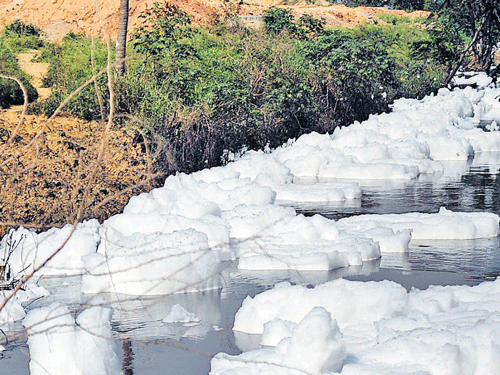
The humongous task of cleaning Bellandur lake may take more time than expected. The civic agencies are of the opinion that the sewage and untreated effluents entering the lake cannot be diverted anywhere, for now.
The Bangalore Water Supply and Sewerage Board (BWSSB), one of the civic agencies primarily held responsible for allowing waste water to enter the lake, has said that until sewage treatment plants (STP) are set up, it would be very difficult to clean Bellandur lake.
The lake is spread across 800 acres and is located on the fringes of the areas newly added to the BBMP limits.
It receives more than 900 million litres (mld) of waste water every day from JP Nagar, Sarakki, Puttenahalli, Bannerghatta Road, Hulimavu, BTM Layout, Madivala and Koramangala areas.
According to a BWSSB official, of the 900 mld of waste water that is let into the lake, the Board is treating sewage in the existing 240-mld- capacity STP located at Koramangala and Chalaghatta valley (K and C valley).
Two hundred mld of waste water treated at this STP is being let back into the lake.
He said there was no way sewage could be diverted at this point of time, and setting up of STPs was the only solution to clean the lake.
The BWSSB has proposed to set up another 60-mld- capacity STP at K and C valley, the work on which is expected to be completed in a year’s time.
Another 150-mld- capacity STP is expected to be completed in the next three years. The Board has also proposed to construct a 90-mld- capacity STP at Bellandur Amanikere which is expected to be completed in the next two years.
Foam formation
The official said that the width of stormwater drains (SWDs) and other inlets into the lake had been reduced to 15 feet from 66 feet.
“It is quite natural for the waste water entering lake to develop pressure at the inlets and form foam,” the official added.
The SWDs had been encroached upon all along with several apartments letting out untreated sewage into the lake. Many industries are also letting out untreated effluents into the lake every day. Pesticides, dyeing agents and waste water from laundries are some of the toxins entering the lakes, the official said.
Apart from the proposed sewage treatment plants, there is a need for smaller STPs to decentralise treating of waste water all along the stormwater drains and in the vicinity of the lake.
There is a need to create awareness among the public on the hazards of lake pollution, the official added.